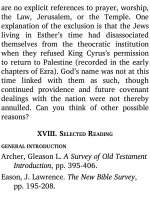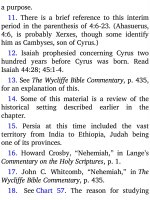Jensens survey of the old testament adam 88
Bạn đang xem bản rút gọn của tài liệu. Xem và tải ngay bản đầy đủ của tài liệu tại đây (166.08 KB, 4 trang )
conservative Christians today, opinion is
perhaps equally divided.8 Internally, there is
nothing to deny the bulk of the book to
Joshua’s pen. The important thing to
recognize is that the identi cation of the
author is not a crucial factor in studying the
Bible text.
B. DATE
The book was written not long after the
events themselves had transpired. If the
conquest of Canaan was completed around
1400 B.C., the book was written soon after
this date. (Note: Concerning dates of this
period of Old Testament history, see John C.
Whitcomb’s
chronological
chart, Old
Testament Patriarchs and Judges.)
About twenty-four years are covered by
the narrative of Joshua. After the Canaanites
were conquered, Joshua divided the land,
settled the tribes in their respective places,
and looked after the a airs of the nation
until his death.
III. SURVEY
1. First, scan the book of Joshua in one
sitting, if possible.
2. Jot down on paper your impressions
from this rst reading (e.g., which part of
the book is mostly narrative?).
3. If your Bible identi es main content at
the top of each page (or at the beginning of
each chapter), read this sequence now, for
the whole book. Also, you may want to read
the first verse of each chapter.
4. Now return to the beginning of the
book, and assign a title to each of the
twenty-four chapters. Record on paper.
(Note that Chart 32 shows a segment
beginning at 11:16 instead of at 12:1.)
5. Read the rst paragraph of the book
(1:1-9) and the last three paragraphs (24:1933). Make comparisons.
6. Before studying the survey Chart 32,
try to group chapters into sections of similar
content. For example:
What chapters are mainly of action?
What chapters record mainly the allotments
of territory?
What
chapters
report
preparations
for
conquest, and what chapters report the
battles themselves?
7. When you read the text in more detail,
look for references to important experiences
of the Israelites, such as altars. Are there
many references in the book to sin of God’s
people, and judgments reaped?
8. The account of the book of Joshua is
presented in a logical sequence of four
sections, as shown on Chart 29.
The rst two sections, comprising the action
section of he book, lead up to a peak of
attaining the promised goal, as represented
by a phrase of the key verse, “So Joshua
took the whole land” (11:23). From this
midpoint of the book, the account levels o
to a plateau, as it were, to present the
immediate business of Joshua, that of
dividing the inheritance of land among the
tribes. This is followed by a tting intense









